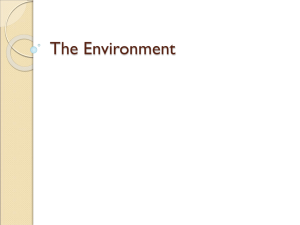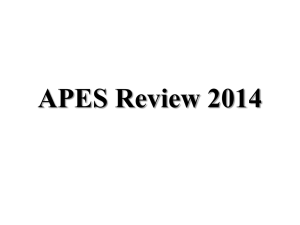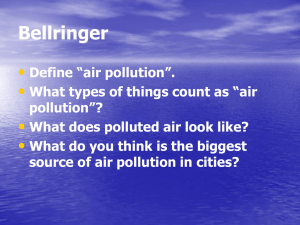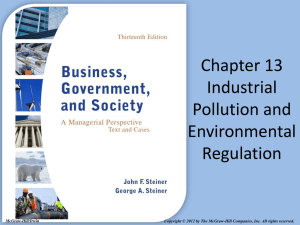Factor Analysis and Dynamics of Water Quality of
advertisement
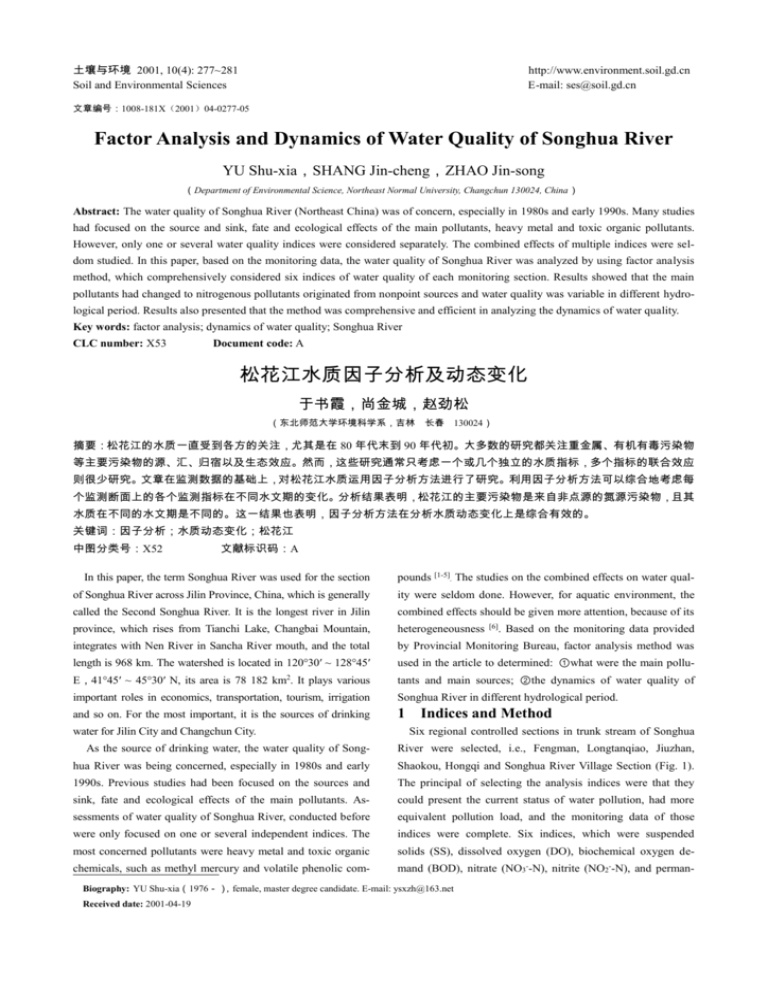
土壤与环境 2001, 10(4): 277~281 Soil and Environmental Sciences http://www.environment.soil.gd.cn E-mail: ses@soil.gd.cn 文章编号:1008-181X(2001)04-0277-05 Factor Analysis and Dynamics of Water Quality of Songhua River YU Shu-xia,SHANG Jin-cheng,ZHAO Jin-song (Department of Environmental Science, Northeast Normal University, Changchun 130024, China) Abstract: The water quality of Songhua River (Northeast China) was of concern, especially in 1980s and early 1990s. Many studies had focused on the source and sink, fate and ecological effects of the main pollutants, heavy metal and toxic organic pollutants. However, only one or several water quality indices were considered separately. The combined effects of multiple indices were seldom studied. In this paper, based on the monitoring data, the water quality of Songhua River was analyzed by using factor analysis method, which comprehensively considered six indices of water quality of each monitoring section. Results showed that the main pollutants had changed to nitrogenous pollutants originated from nonpoint sources and water quality was variable in different hydrological period. Results also presented that the method was comprehensive and efficient in analyzing the dynamics of water quality. Key words: factor analysis; dynamics of water quality; Songhua River CLC number: X53 Document code: A 松花江水质因子分析及动态变化 于书霞,尚金城,赵劲松 (东北师范大学环境科学系,吉林 长春 130024) 摘要:松花江的水质一直受到各方的关注,尤其是在 80 年代末到 90 年代初。大多数的研究都关注重金属、有机有毒污染物 等主要污染物的源、汇、归宿以及生态效应。然而,这些研究通常只考虑一个或几个独立的水质指标,多个指标的联合效应 则很少研究。文章在监测数据的基础上,对松花江水质运用因子分析方法进行了研究。利用因子分析方法可以综合地考虑每 个监测断面上的各个监测指标在不同水文期的变化。分析结果表明,松花江的主要污染物是来自非点源的氮源污染物,且其 水质在不同的水文期是不同的。这一结果也表明,因子分析方法在分析水质动态变化上是综合有效的。 关键词:因子分析;水质动态变化;松花江 中图分类号:X52 文献标识码:A In this paper, the term Songhua River was used for the section pounds [1-5]. The studies on the combined effects on water qual- of Songhua River across Jilin Province, China, which is generally ity were seldom done. However, for aquatic environment, the called the Second Songhua River. It is the longest river in Jilin combined effects should be given more attention, because of its province, which rises from Tianchi Lake, Changbai Mountain, heterogeneousness integrates with Nen River in Sancha River mouth, and the total by Provincial Monitoring Bureau, factor analysis method was length is 968 km. The watershed is located in 120°30′ ~ 128°45′ used in the article to determined: ①what were the main pollu- E,41°45′ ~ 45°30′ N, its area is 78 182 km2. It plays various tants and main sources; ②the dynamics of water quality of important roles in economics, transportation, tourism, irrigation Songhua River in different hydrological period. and so on. For the most important, it is the sources of drinking 1 Indices and Method water for Jilin City and Changchun City. [6]. Based on the monitoring data provided Six regional controlled sections in trunk stream of Songhua As the source of drinking water, the water quality of Song- River were selected, i.e., Fengman, Longtanqiao, Jiuzhan, hua River was being concerned, especially in 1980s and early Shaokou, Hongqi and Songhua River Village Section (Fig. 1). 1990s. Previous studies had been focused on the sources and The principal of selecting the analysis indices were that they sink, fate and ecological effects of the main pollutants. As- could present the current status of water pollution, had more sessments of water quality of Songhua River, conducted before equivalent pollution load, and the monitoring data of those were only focused on one or several independent indices. The indices were complete. Six indices, which were suspended most concerned pollutants were heavy metal and toxic organic solids (SS), dissolved oxygen (DO), biochemical oxygen de- chemicals, such as methyl mercury and volatile phenolic com- mand (BOD), nitrate (NO3--N), nitrite (NO2--N), and perman- Biography: YU Shu-xia(1976-) ,female, master degree candidate. E-mail: ysxzh@163.net Received date: 2001-04-19 土壤与环境 278 Vol.10 No.4 agriculture, and the abundance of those matters losing with soil erosion were increasing correspondingly. Hence the nitrogenous pollutants carried in eroded soil were the main factors influence water quality. DO was the dominant factor that controlled the transformation between NO3--N and NO2--N. The second component characterized organic pollution in river. BOD and CODMn had high load, 0.916 and 0.920 respectively, and the rest were low. These two components present 95.6% of original information contained by the six indices, so they could substitute these six indices to demonstrate water quality of the river. According to the two components, main influent factors were nitrogenous pollutants and SS (as the main carrier of nitrogenous pollutants), just as the first component presented; Furthermore, organic matters influence water quality to a certain degree, which presented by the second component. For each section, component scores were calculated and Fig. 1 Sketch map of water quality monitor sections of Songhua River in Jilin Province showed in Fig. 3. In Songhua River Village section, the main pollutants were SS and nitrogenous pollutants. Land use form ganate index (CODMn), were selected to perform the following in this area was mainly paddy fields and dry farmland. Dis- analyses. The main pollutants, such as volatile phenolic com- turbed by human development, soil was eroded seriously. The pounds and methyl mercury, which had been investigated in amount of losing fertilizer and pesticide were enormous, which 1980s and early 1990s by other authors, have low concentra- was the main source of water pollution in this area tions or cannot be detected now. Hence those indices were not section was polluted by nonpoint source pollution and water selected because of their slight influence on water quality. quality in this section was poor. Fengman and Longtanqiao [3]. This According to the monitoring data provided by the provincial sections were set in the third quadrant, and both had high nega- monitoring center, the data of different hydrological period in tive scores, which indicated water quality in these two sections each section were selected. The statistical analysis of those was good. Neither nitrogenous pollutants nor organic pollutants indices was performed with Factor Analysis program, SPSS for polluted these two sections, mainly these two sections lies in personal computers. The results which were shown in table 1~3 the upper reaches of Songhua River and Jilin City, without the and figure 2~7, were used to assess the comprehensive water influence of municipal wastewater and topography in this area quality and the influence that the different component had on is not suitable for cultivate and vegetation was less destroyed. water quality. The scores of Shaokou and Jiuzhan were put near the second 2 Results and Discussions component axis in the second quadrant, and score of the second 2.1 Dynamics of water quality in different hydrological pe- component were positive and high, so organic pollutants influ- riods enced water quality of these two sections dominantly. The 2.1.1 level period causes were that these two sections lie in lower reaches of Jilin The results of Factor Analysis in level period were shown in City, took the polluted water from Jilin City, which are con- table 1 and figures 2~3. The first component indicated nitroge- taminated by domestic sewage and polluted water discharged nous pollution in the river. In positive side of the first compo- Table 1 nent axis, SS, NO3--N, NO2--N had high load, they were 0.999, Components 0.990, 0.980 respectively; in terms of negative side, DO has high negative load (-0.996). SS was the main carrier of nitrogenous pollutants, and NO3--N, NO2--N were the main form of Rotated Component Matrix 1 2 SS .999 4.602E-03 DO -.996 -6.307E-03 nitrogenous pollutants in Songhua River. The major sources of NO2 --N .990 8.107E-02 these pollutants were soil erosion and nutrients losing with NO3--N .980 -9.721E-02 rain-off, which were caused by the improper cultivation in ag- CODMn .231 .920 riculture. More and more fertilizer and pesticides were used in BOD -.234 .916 于书霞等:松花江水质因子分析及动态变化 Component 1 BOD CODMn NO3--N DO SS NO3--N 279 Factor score 2 for analysis Vol.10 No.4 Component 2 Fig. 2 The Rotated Principal Component Factor score 1 for analysis Fig. 3 by factories, such as Jilin Chemical Industry Corporation. Table 2 Rotated Component Matrix These two sources were the main pollution source. 2.1.2 The Loading Plot of Component Scores Components high level period 1 2 3 .950 -8.869E-03 .115 -.943 -.151 -.275 The results of Factor Analysis in high-level period were shown in table 2 and figure 4~5. For the first component, the important indices which had positive value was DO (0.950), DO --N NO2 had the highest load, -0.943. CODMn .750 -.326 -.399 The results showed that, in high level period, main index to NO3--N -.208 .976 -1.381E-02 determine water quality was DO. When the amount of DO was SS .194 .936 -.232 not sufficient, water would be in reducing condition, and then BOD .140 -.205 .924 while in negative axis, NO2 --N NO2 --N would be the main pollutants. The second component demonstrated that, in high-level period, SS and NO3--N were another factors that influenced water SS quality, for SS and NO3--N had high load in the second com- NO3--N ponents, 0.936 and 0.976 respectively. It indicated that nitroghigh-level period. In this hydrological period, when water was adequate, and there were certain delusion effects, NO2--N had more effect on water quality than suspend solids and NO3--N. DO Component 3 enous source pollutants were still the main pollutants in BOD CODMn NO2--N The third component is necessary to demonstrate water quality in this period, because the former two components hadn’t contained more than 85% of original information, and can’t substituted original indices. The third component mainly presented BOD index, which has the highest load, 0.924, so biodegrada- Fig. 4 The Rotated Principal Component ble organic matters were another kind of pollutants in this hydrological period. component axis, and had positive scores. It indicated that water in these two sections had high level of dissolved oxygen, and water quality had been slightly influenced by any involved pollutants. Especially in Fengman section, water quality is better than any other sections. In Jiuzhan and Shaokou sections, Factor score 2 for analysis In the loading plot of component scores (Fig. 5), the two sections, Fengman and Longtanqiao were located near the first water quality was mainly influenced by organic chemicals, especially biodegradable organic chemicals. In Hongqi section, water had relative high NO2--N pollution load; In Songhua Factor score 1 for analysis Fig. 5 The Loading Plot of Component Scores 土壤与环境 280 Vol.10 No.4 village section, water quality was still influenced by suspended Table 3 Rotated Component Matrix solids and NO3--N. 2.1.3 Components low-level period The factor analysis in low-level period were shown in table 3 and figure 6~7. The main water quality indices that were char- 1 2 DO -.984 .105 SS .958 -7.586E-02 acterized by the first component were SS (0.958), NO3--N NO3--N .951 .126 (0.951), and DO (-0.984). It indicated that, in low level period, BOD .224 .944 water quality was determined by DO, which could take as a NO2--N -.413 .828 constrain factor, nitrogenous source pollutants and its carrier, CODMn -.279 .216 SS, were two important pollutants. The first component accounted for 59.3% of the total variation. NO2--N COD The second component presented that, in low-level period, biodegradable organic chemical was another important index. BOD Component 2 Mn NO2--N also had relative high load, which indicated that water quality in this period was affected by NO2--N to certain degree and it was not as high as that in the other two hydrological peri- DO NO3--N SS ods.In the loading plot of component scores (Fig.7), it presented that six sections were clearly classified into three categories. Fengman and Longtanqiao were laid in third quadrant, and Absolute value of scores was small. Both had better water quality, Fig. 6 for these two sections were both influenced by neither nitroge- Component 1 The Rotated Principal Component nous pollutants nor biodegradable organic chemicals. Jiuzhan, Factor score 2 for analysis Hongqi and Shaokou sections lied near the second component axis and had relatively high scores. Biodegradable organic chemicals and NO2--N mainly affected water in these three sections. In the loading plot, Songhua village section was near positive section of the first component and score was high, so water quality in this section was mainly affected by NO3--N and SS. In summary, the indices that influenced water quality in different hydrological period and different section were different. In the three hydrological periods, water quality was mainly Fig. 7 Factor score 1 for analysis The Loading Plot of Component Scores affected by suspended solids and nitrogenous source pollutants. Songhua village section lies in the region where agriculture was 2.2 Source of pollutants well developed and original vegetation had been destroyed, and 2.2.1 Nonpoint source pollution soil erosion and nutrient losing in this area is serious. The ma- From Factor Analysis results, in the watershed of Songhua jor pollutants come from fields on both sides of this river sec- River, nonpoint source pollution was an important source of tion. Water in Jiuzhan and Shaokou was mainly polluted by water pollution. biodegradable chemical matter, discharged by industry of Jilin Nonpoint source pollutants are recognized as the major con- City, especially by Jilin Chemical Industrial Corporation; an- tributors to surface and groundwater contamination worldwide, other source was municipal domestic sewage. Indices that in- 30% to 50% of the earth’s surface is believed to be affected by fluenced water quality in Hongqi section were varied in differ- nonpoint source pollutants and at the same time, agriculture ent period, level period had better conditions, and neither or- remains, including pesticides are the single greatest contribute ganic chemicals nor nitrogenous pollution was serious. In of nonpoint source pollutants. Nonpoint source pollution has its was the main pollutant. In low-level own characteristics. They are broad areal extent, heavy pollu- period, the main indices that influence water quality were bio- tion load, difficult to monitor and control. The cause of the --N high-level period, NO2 --N. degradable organic chemicals and NO2 In upper reaches, human being imposed less influence on water quality in Fengman section. aggravation of nonpoint source pollution were following: ①With the population growth, the pressure on environment was increasing correspondingly. Some factors, for example, 于书霞等:松花江水质因子分析及动态变化 Vol.10 No.4 281 increasing land cultivation and inappropriate land use contrib- Shaokou section was mainly affected by organic pollutants. It uted to bring the degradation of ecosystem and caused the sta- indicated that industry, especially large corporations still have bility of the ecosystem decreasing seriously. The population in fair influence on water quality Jilin Province had constantly growth from 80s to 90s, took 3 Conclusions 1996 as an example, Changchun City and Jilin City, the two Because of the important roles of Songhua River, water biggest cities in Songhua River watershed, had high natural quality and pollution status was always of concern, especially population growth rates, 8.22‰ and 4.57‰ respectively. With in 80s and early 90s. However, previous studies paid more the constant and fast growth of population, the pressure on attention on the source and sink, fate or ecological effects of ecosystem was increasing. In this watershed, the proportion of one or several main pollutants. The assessment of water quality agriculture people was high, which led to the demand of more also based on one or several separately indices. In this paper, field and large area of forest, pasture and sloping field were Factor Analysis method was used for comprehensively consid- converted to cultivated field. The percentage of forest coverage ering six indices of each control section and assessing dynam- had been decreased. For example, in upper reaches, the per- ics of water quality in different hydrological period. centage of forest coverage was more than 60% in 60s, and now The results showed that main pollutants in Songhua River, it was only about 51.14%. On the other hand, the agriculture has been changed from the heavy metal and toxic organic cultivation in this area was extensive, which made the soil chemicals in 80s and early 90s, which caused by point source eroded seriously and soil fertility deceased sharply. The losing pollution, to nitrogen source chemicals, which mainly caused nutrient was important source of pollutants of Songhua River. by nonpoint source pollution. The pollutants that influenced the ②Single-crop cultivation and the reliance on crops produc- water quality seriously were nitrogenous source and suspended tion made people increase the investment in agriculture. The solid, which mainly come from agriculture cultivation, and amount of utilized fertilizer and pesticides had continuously urban runoff, i.e., nonpoint source. And it’s difficult control just hm2 adapted the same means as in controlled point sources pollution, was between 30 and 45 kg, however, in 1996, the average for example, heavy metal or organic chemicals from sewage increasing. In the 60s, the average amount of fertilizer per amount reached to 591.6 kg per hm2, increased about 15.78 discharge. folds, which far beyond the average amount of worldwide (94.5 kg per hm2). Based on the condition of the area studied, forest protection, The type of the fertilizers generally used in this innovations of agriculture cultivation, and improvement of area was single and unchangeable, and nitrogenous fertilizer storage ability of runoff in urban area, might be the most im- had the highest proportion. According to the long-term agricul- portant methods to control the nonpoint source pollution and tural test stations, the average utilizing efficiency of fertilizer is improve water quality of Songhua River. 27%~30%, about 60% of nitrogenous fertilizer was losing with surface runoff. Except for the portion being cut-off by surface Reference: [1] or being absorbed by other materials, about 20% or more of the fertilizer was abouched to river. ③With the expansion of cities, more fields were urbanized; vance in Environmental Science, 1993, 1(2): 74-80 (in Chinese). [2] LANG PEIZHEN, DING YUNZHENG, LONG FENGSHAN, et al. A study of the pollution of toxic organic in the Songhua River between the ability of storage, buffering of roads and building to rain or middle reaches Shaokou and Songhua River Village[J]. Advance in storm in cities was clearly weakened. The amount of solid waste, especially domestic wastes carried by urban surface DING YUNZHENG, LANG PEIZHEN, LONG FENGSHAN, et al. A study on the organic pollutants of the second Songhua River[J]. Ad- Environmental Science, 1993, 1(1): 47-56 (in Chinese). [3] LIU JINGSHUANG, YU JUNBAO, YANG BAIXING, et al. Nitrogen runoff was growing rapidly. It was another important source of content dynamic variation analysis in the Second Songhua River[J]. nonpoint source pollution for water body. China Journal of Environmental Science, 1997, 18(1): 14-16 (in Chinese). 2.2.2 Point source Pollution In recent years, environmental pollution had evoked people’s [4] attention. The control and treatment of point source pollution Lake[J]. Research of Environmental Science, 1999, 12(1): 26-29 (in had been enforced. Based on monitoring data of water quality, the main pollutants has been changed from toxic industrial WANG NING, ZHU YANMING, LI SHUN. Analysis of dynamic variations and forming reasons of nourishment material in Songhua Chinese). [5] WU SHIAN, ZHANG GUILING, XU JIE, et al. Environmental epi- pollutants, such as point source pollutants i.e., mercury, volatile denmiological study on the chronic methylmercury poisoning along phenolic compounds, to nonpoint sources pollutants, such as the Songhua River[J]. China Environmental Science, 1994, 14(4): nitrogenous pollutants. It indicated that control for industrial pollutants was enforced, and toxic organic chemicals and heavy 268-272 (in Chinese). [6] LIAO ZHIQI, LU XIAOHUA. The factor analysis of environmental chemical characteristics in Sandan Lake[J]. Journal of Huazhong metal had been controlled to certain degree. However, based on University of Science and Technology, 1998, 26(sup.Ⅱ ): 65-67 (in the results of Factor Analysis, water quality of Jiuzhan, Chinese).





